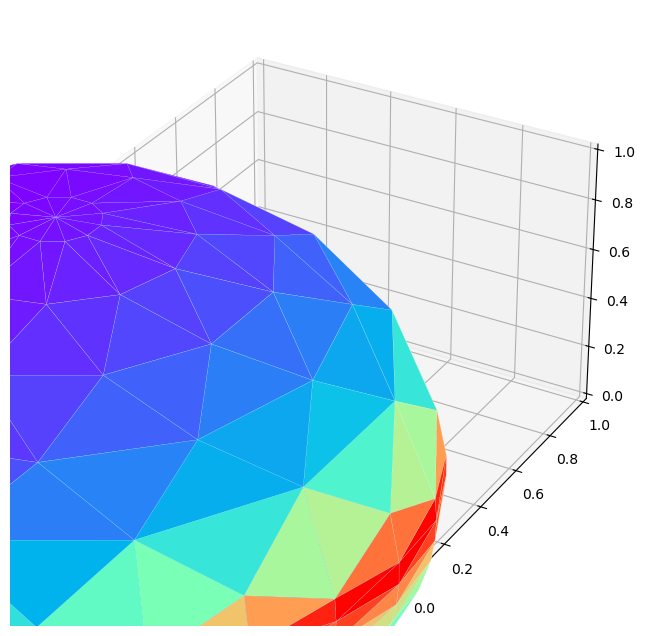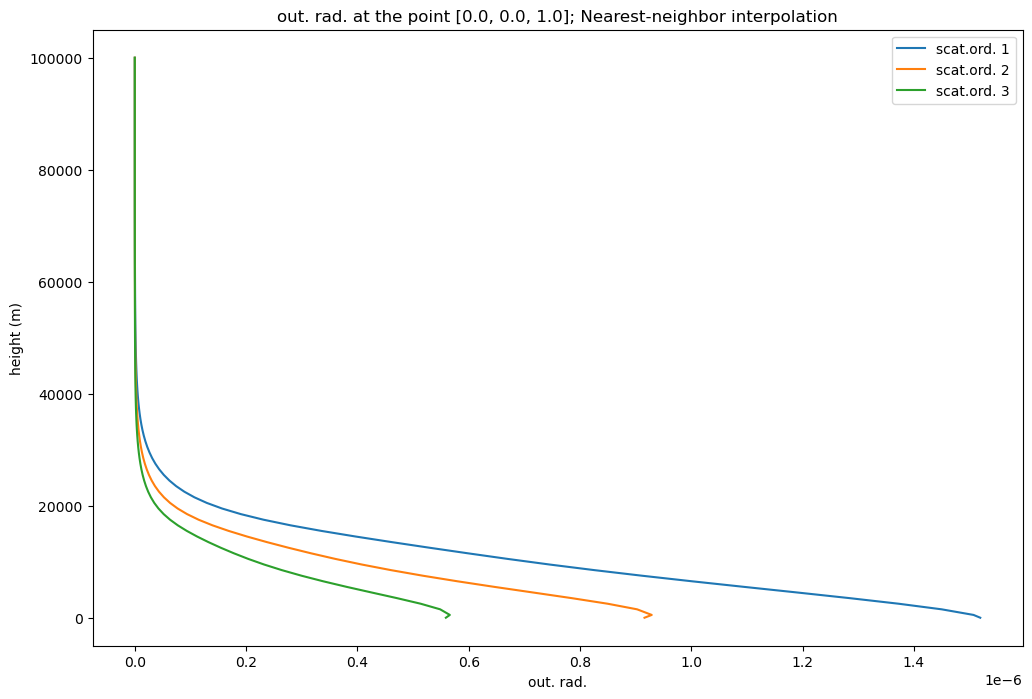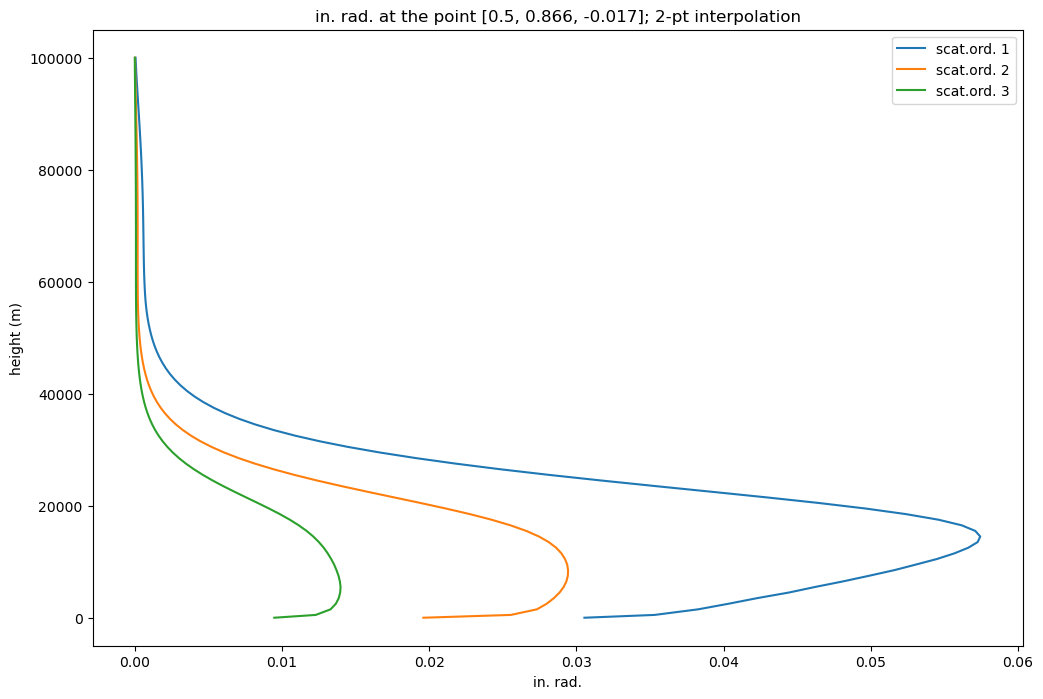Collecting diagnostic data during radiative transfer calculation with HR¶
In this example we collect diagnostic data, namely in- and out-radiance at specified diffuse profiles and orders of scattering, and store it to an hdf5 file. To enable data collection, at least one of the following two HR engine options should be set:
diagnosticscatterorders - the list of orders of scattering,
diagnosticdiffuseprofiles - the list of diffuse profiles.
If only one option is set manually, the second will be set to default value. Deafults are [1] for the scattering orders and [0] for the diffuse profiles.
The data is stored to DiagnosticData.h5 file in the working directory. If the file already exists, it is overwritten.
To stop collecting diagnostic data without re-initializing the engine, one should set both parameters to zero-length arrays: engine.options[‘optname’] = [].
[1]:
%matplotlib inline
[2]:
import sasktran as sk
from sasktran.geometry import VerticalImage
import numpy as np
import matplotlib.pyplot as plt
import h5py
[3]:
# Create geometry
tanalts = [15, 25, 35]
geometry = VerticalImage()
geometry.from_sza_saa(sza=60, saa=60, lat=0, lon=0, tanalts_km=tanalts, mjd=54372,
locallook=0, satalt_km=600, refalt_km=20)
# Create an atmosphere with aerosol absorption and Rayleigh scattering
atmosphere = sk.Atmosphere()
atmosphere['air'] = sk.Species(optical_property=sk.Rayleigh(), climatology=sk.MSIS90())
engine = sk.EngineHR(geometry=geometry, atmosphere=atmosphere)
wlens = [350, 400]
engine.wavelengths = wlens
# To collect diagnostic data,
# specify scattering orders
myorders = [1,2,3]
engine.options['diagnosticscatterorders'] = myorders
# Use more than one diffuse profile
engine.options['numdiffuseprofilesinplane'] = 3
myprofiles = [0,1,2]
engine.options['diagnosticdiffuseprofiles'] = myprofiles
# Execute
rad = engine.calculate_radiance()
One can have a look at the list of data that was collected:
[4]:
h5f = h5py.File('DiagnosticData.h5', 'r')
print('The following diagnostic data was stored:')
for k in h5f.keys():
dsinf = str(h5f[k])
print(dsinf[14:dsinf.find(')')+1])
h5f.close()
The following diagnostic data was stored:
"heights": shape (102,)
"in_wlen_350.00_ord_1_ground": shape (3, 133)
"in_wlen_350.00_ord_1_prof_0": shape (102, 290, 4)
"in_wlen_350.00_ord_1_prof_1": shape (102, 290, 4)
"in_wlen_350.00_ord_1_prof_2": shape (102, 290, 4)
"in_wlen_350.00_ord_2_ground": shape (3, 133)
"in_wlen_350.00_ord_2_prof_0": shape (102, 290, 4)
"in_wlen_350.00_ord_2_prof_1": shape (102, 290, 4)
"in_wlen_350.00_ord_2_prof_2": shape (102, 290, 4)
"in_wlen_350.00_ord_3_ground": shape (3, 133)
"in_wlen_350.00_ord_3_prof_0": shape (102, 290, 4)
"in_wlen_350.00_ord_3_prof_1": shape (102, 290, 4)
"in_wlen_350.00_ord_3_prof_2": shape (102, 290, 4)
"in_wlen_400.00_ord_1_ground": shape (3, 133)
"in_wlen_400.00_ord_1_prof_0": shape (102, 290, 4)
"in_wlen_400.00_ord_1_prof_1": shape (102, 290, 4)
"in_wlen_400.00_ord_1_prof_2": shape (102, 290, 4)
"in_wlen_400.00_ord_2_ground": shape (3, 133)
"in_wlen_400.00_ord_2_prof_0": shape (102, 290, 4)
"in_wlen_400.00_ord_2_prof_1": shape (102, 290, 4)
"in_wlen_400.00_ord_2_prof_2": shape (102, 290, 4)
"in_wlen_400.00_ord_3_ground": shape (3, 133)
"in_wlen_400.00_ord_3_prof_0": shape (102, 290, 4)
"in_wlen_400.00_ord_3_prof_1": shape (102, 290, 4)
"in_wlen_400.00_ord_3_prof_2": shape (102, 290, 4)
"out_wlen_350.00_ord_1_ground": shape (3,)
"out_wlen_350.00_ord_1_prof_0": shape (102, 169, 4)
"out_wlen_350.00_ord_1_prof_1": shape (102, 169, 4)
"out_wlen_350.00_ord_1_prof_2": shape (102, 169, 4)
"out_wlen_350.00_ord_2_ground": shape (3,)
"out_wlen_350.00_ord_2_prof_0": shape (102, 169, 4)
"out_wlen_350.00_ord_2_prof_1": shape (102, 169, 4)
"out_wlen_350.00_ord_2_prof_2": shape (102, 169, 4)
"out_wlen_350.00_ord_3_ground": shape (3,)
"out_wlen_350.00_ord_3_prof_0": shape (102, 169, 4)
"out_wlen_350.00_ord_3_prof_1": shape (102, 169, 4)
"out_wlen_350.00_ord_3_prof_2": shape (102, 169, 4)
"out_wlen_400.00_ord_1_ground": shape (3,)
"out_wlen_400.00_ord_1_prof_0": shape (102, 169, 4)
"out_wlen_400.00_ord_1_prof_1": shape (102, 169, 4)
"out_wlen_400.00_ord_1_prof_2": shape (102, 169, 4)
"out_wlen_400.00_ord_2_ground": shape (3,)
"out_wlen_400.00_ord_2_prof_0": shape (102, 169, 4)
"out_wlen_400.00_ord_2_prof_1": shape (102, 169, 4)
"out_wlen_400.00_ord_2_prof_2": shape (102, 169, 4)
"out_wlen_400.00_ord_3_ground": shape (3,)
"out_wlen_400.00_ord_3_prof_0": shape (102, 169, 4)
"out_wlen_400.00_ord_3_prof_1": shape (102, 169, 4)
"out_wlen_400.00_ord_3_prof_2": shape (102, 169, 4)
[5]:
# Keep the first file under different name
import os
def convert_bytes(num):
for x in ['bytes', 'KB', 'MB', 'GB', 'TB']:
if num < 1024.0:
return "%3.1f %s" % (num, x)
num /= 1024.0
def file_size(file_path):
if os.path.isfile(file_path):
file_info = os.stat(file_path)
return convert_bytes(file_info.st_size)
fname = 'DiagnosticData.h5'
# print the file size
print(fname, ' :', file_size(fname))
DiagnosticData.h5 : 25.9 MB
[6]:
# To dismiss collecting diagnostic data:
engine.options['diagnosticscatterorders'] = []
engine.options['diagnosticdiffuseprofiles'] = []
# Execute
rad = engine.calculate_radiance()
WARNING :ISKEngine HR, The diagnosticscatterorders property has 0 length; Diagnostics will most likely be disabled
WARNING :ISKEngine HR, The diagnosticdiffuseprofiles property has 0 length; Diagnostics will most likely be disabled
Note: for polarized light scattering, the shape of incoming radiance data is (nheights, npoints, 10), and row structure is [x, y, z, rad, true_x, true_y, true_z, stokes_x, stokes_y, stokes_z]
Following are two useful plotting functions to visualize the collected data.
[7]:
def plotOnSphere(fname, wlen, type = 'in', order = 1, profile = 0, height=4500,
mycolormap = plt.cm.coolwarm):
from mpl_toolkits.mplot3d import Axes3D
from mpl_toolkits.mplot3d.art3d import Poly3DCollection
from scipy.spatial import ConvexHull
import matplotlib.colors as colors
h5f = h5py.File(fname, 'r')
heights = np.array( h5f.get('heights') )
# get 3d rad data
# non-polarized: [heights][points][x y z rad]
# polarized: [heights][points][x y z rad tru_x tru_y tru_z stokes_x stokes_y stokes_z]
rads = np.array( h5f.get(type + '_wlen_' + '%.2f'%wlen + '_ord_' + str(order) +
'_prof_' + str(profile)) )
h5f.close()
hidx = np.abs(heights-height).argmin()
rad = rads[hidx]
rad = rad[np.argsort(rad[:,3])]
xyz, rvals = rad[:,0:3], rad[:,3]
hull = ConvexHull(xyz)
idxs = hull.simplices
verts = xyz[idxs]
facevals = np.average(rvals[idxs], axis=1)
mynorm = plt.Normalize(min(facevals), max(facevals))
facecols = mycolormap(mynorm(facevals))
coll = Poly3DCollection(verts, facecolors=facecols, edgecolors='white', linewidths=0.1)
fig = plt.figure(figsize=(10,8))
ax = fig.add_subplot(projection='3d')
ax.add_collection(coll)
ax.axis([-1, 1,-1, 1]), ax.set_zlim(-1, 1)
ax.set_xlabel('X'), ax.set_ylabel('Y'), ax.set_zlabel('Z')
m = plt.cm.ScalarMappable(cmap=mycolormap)
m.set_array([min(facevals),max(facevals)])
fig.colorbar(m, shrink=0.5, aspect=15, ticks=np.linspace(min(facevals),
max(facevals), 10))
plt.tight_layout()
plt.title(type+' radiance, wavelength = ' + '%.2f'%wlen +
'; profile = ' + str(profile) + '; order of scatter = ' +
str(order) + '; height = ' + str(height))
plt.show()
plt.close()
def plot2DHeightProf(fname, wlen, type = 'in', orders=[1,2,3], profile=0, point = [0. ,0., 1.],
theta = None, phi = None, np2int = 4):
# where np2int is a number of points to interpolate
# and the target point can be specified either as [x y z] or as {theta, phi}
if (theta is not None) and (phi is not None):
theta = np.radians(theta)
phi = np.radians(phi)
point[0] = np.sin(theta)*np.cos(phi)
point[1] = np.sin(theta)*np.sin(phi)
point[2] = np.cos(theta)
h5f = h5py.File(fname, 'r')
heights = np.array( h5f.get('heights') )
h5f.close()
mylegend = []
fig = plt.figure(figsize=(12,8))
for order in orders:
rads = []
h5f = h5py.File(fname, 'r')
# get 3d rad data
# n/pol.: [heights][points][x y z rad]
# pol.: [heights][points][x y z rad tru_x tru_y tru_z stokes_x stokes_y stokes_z]
rad = np.array( h5f.get(type + '_wlen_' + '%.2f'%wlen + '_ord_' +
str(order) + '_prof_' + str(profile)) )
h5f.close()
for hidx in range(len(rad)):
mynum, myden = 0, 0
mags = np.linalg.norm(rad[hidx,:,0:3] - point, axis=1)
if ( mags[np.argmin(mags)] < 1e-6 ) or ( np2int == 1 ):
#if perfect match found, ignore np2int
rads.append(rad[hidx, np.argmin(mags), 3])
else:
# use modified Shepard interp. for limited num. points
my_radius = mags[np.argsort(mags)[np2int]]
for npt in range(np2int):
coef = pow( max( 0, my_radius-mags[np.argsort(mags)[npt]]) /
( mags[np.argsort(mags)[npt]] * my_radius), 2)
mynum += coef * rad[hidx, np.argsort(mags)[npt], 3]
myden += coef
rads.append( mynum / myden )
mylegend.append('scat.ord. ' + str(order))
plt.plot(rads, heights)
plt.legend(mylegend)
plt.ylabel('height (m)')
plt.xlabel(type + '. rad.')
if np2int == 1: subtitle = 'Nearest-neighbor interpolation'
else: subtitle = str(np2int) + '-pt interpolation'
plt.title(type + '. rad. at the point ' +
"[%s]"%", ".join(map(str,np.around(point,decimals=3))) +
'; ' + subtitle)
plt.show()
plt.close()
[8]:
fname = 'DiagnosticData.h5'
# - plot on unisphere, one plot per one order, profile, height
plotOnSphere(fname, 350, 'in', order=1, profile=2, height=10500, mycolormap = plt.cm.rainbow)
plotOnSphere(fname, 350, 'out', order=1, profile=2, height=10500, mycolormap = plt.cm.rainbow)
# - plot on unisphere, one plot per one order, profile, height
plotOnSphere(fname, 400, 'in', order=2, profile=0, height=0.01)
plotOnSphere(fname, 400, 'out', order=2, profile=0, height=0.01)
---------------------------------------------------------------------------
TypeError Traceback (most recent call last)
Cell In[8], line 4
1 fname = 'DiagnosticData.h5'
3 # - plot on unisphere, one plot per one order, profile, height
----> 4 plotOnSphere(fname, 350, 'in', order=1, profile=2, height=10500, mycolormap = plt.cm.rainbow)
5 plotOnSphere(fname, 350, 'out', order=1, profile=2, height=10500, mycolormap = plt.cm.rainbow)
6 # - plot on unisphere, one plot per one order, profile, height
Cell In[7], line 34, in plotOnSphere(fname, wlen, type, order, profile, height, mycolormap)
32 ax = fig.add_subplot(projection='3d')
33 ax.add_collection(coll)
---> 34 ax.axis([-1, 1,-1, 1]), ax.set_zlim(-1, 1)
35 ax.set_xlabel('X'), ax.set_ylabel('Y'), ax.set_zlabel('Z')
37 m = plt.cm.ScalarMappable(cmap=mycolormap)
File /usr/share/miniconda/envs/doc_env/lib/python3.9/site-packages/matplotlib/axes/_base.py:2112, in _AxesBase.axis(self, arg, emit, **kwargs)
2110 if arg is not None:
2111 if len(arg) != 2*len(self._axis_names):
-> 2112 raise TypeError(
2113 "The first argument to axis() must be an iterable of the form "
2114 "[{}]".format(", ".join(
2115 f"{name}min, {name}max" for name in self._axis_names)))
2116 limits = {
2117 name: arg[2*i:2*(i+1)]
2118 for i, name in enumerate(self._axis_names)
2119 }
2120 else:
TypeError: The first argument to axis() must be an iterable of the form [xmin, xmax, ymin, ymax, zmin, zmax]

[9]:
fname = 'DiagnosticData.h5'
# - or plot a height profile for particular diffuse point
plot2DHeightProf(fname, 350, orders=myorders, profile=0, point=[-0.5, 0.85, -0.1])
plot2DHeightProf(fname, 350, type='out', orders=myorders, profile=2, np2int=1)
plot2DHeightProf(fname, 400, theta=91, phi=60, np2int=2)


